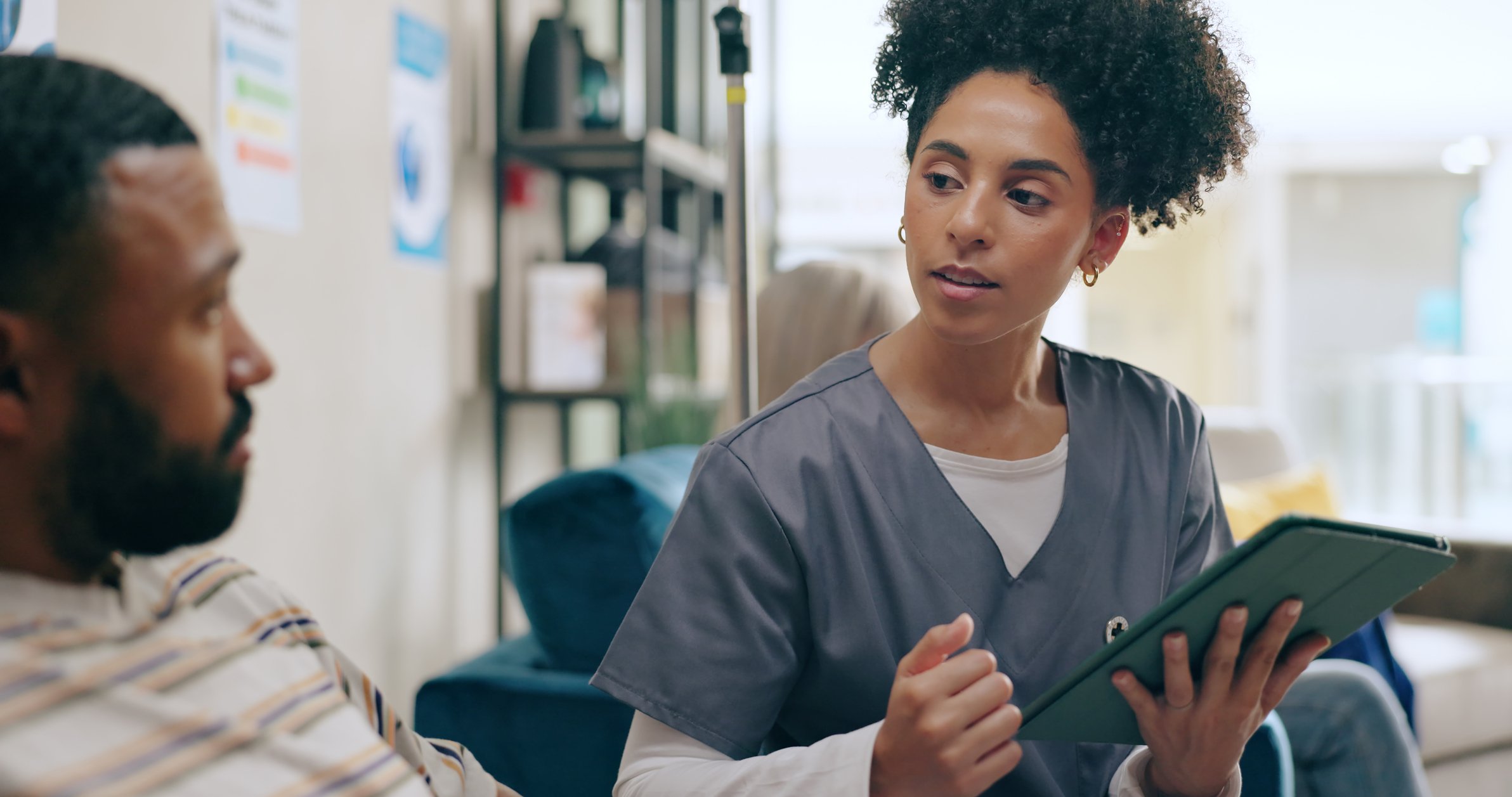A Day in the Life of A Patient
By Stephanie Wilborne, APRN FNP
Contributing author to DiversityNursing.com
John takes five pills every day. He does not know the names of all his medications, but he recognizes each pill by its shape and color. Taking medications every day is a struggle for John. Sometimes he forgets to take his pills. Frequently, he has problems paying for his prescriptions. John missed two appointments to see the eye doctor. He forgot about the first appointment and was so late for the second, they refused to see him. He's been told in the past that people with diabetes have a "higher risk" of eye problems. John still does not understand why he needs to see an eye doctor.
John is your patient today. His blood pressure reading is high again. And unfortunately, his hemoglobin A1c readings are still too high. His diabetes and hypertension are poorly controlled. You ask what pills he takes. He can’t remember. Reading in his chart, you see at his last visit he was given a list of all his medications. Trying to figure out why his high blood pressure and diabetes are uncontrolled, you ask tons of questions. "Are you taking your medication every day? Why did you miss the second eye appointment,” you ask him? Frustration sets in.
The term health literacy refers to a set of skills people need to effectively manage their health. More than two decades of research has associated poorer health literacy skills with less frequent screening for diseases such as cancer, higher rates of disease, mortality and worse health outcomes. It is important for health care providers to understand that patients with poorer health literacy skills may struggle at times with health related tasks.
Taking Medications: May have difficulty reading prescription bottles and understanding when, how and how often to properly take medications.
Disease Self Management Skills: May have less knowledge concerning their disease or condition resulting in poorer disease and self management skills. For example, diabetic patients with poorer math skills are more likely to have problems interpreting glucometer readings and therefore miss that blood sugars are too high, low or normal.
Risk: May have difficulty understanding the concept of risk and how it may impact their health.
Navigation: Patients with poorer reading skills may have difficulty reading a bus schedule, following directions and other hospital or healthcare signage.
Communication: Patients with poorer health literacy skills are more likely to report problems understanding and following conversations and verbal instructions of health care providers.
In 2003 the National Assessment of Adult Literacy for the first time measured the health literacy level of more than 26, 000 American adults. Only 12% of Americans were found to have proficient health literacy skills. Based on this data, the majority of adults may have problems functioning in our current healthcare system at different times of their life. Unfortunately, health information that patient's receive from health care professionals is often too complex for them to understand. The United States government, American Medical Association, Joint Commission and many other agencies are advocating that all health care professionals incorporate clear communication techniques and strategies into clinical practice with ALL patients.
John’s nurse turned her frustration into action. How many times a day he needs to take his medication was reduced to once a day. His prescriptions are now written for a 90 day supply. To help John manage his diabetes and hypertension better, John sees a nurse or clinician more often. His health care team has completed training on utilizing clear communication techniques and strategies into clinical practice. John now receives verbal and print instruction that incorporates plain language principles with less medical jargon. Teach back is used to confirm understanding. Brief conversations with John revealed he didn’t know that much at all about diabetes or hypertension. His clinician and nurse devised a plan to provide short bursts of education for future appointments. They are also trying to coax John into attending diabetes self management classes And yes, John finally had an eye appointment. His nurse arranged for a family member to take him to his appointment.
All of the interventions mentioned above are based on more than two decades of research on how to improve the health care delivery and health outcomes for patients with poorer health literacy skills. How health care providers communicate and deliver care can improve the ability of patients with poorer health literacy skills to manage their own health. Nurses, we have the power to transform our healthcare system. Learn more about health literacy and incorporate clear communication into your clinical practice.
Stephanie Wilborne, APRN FNP
www.health-lit.com/
By Stephanie Wilborne, APRN FNP
Contributing author to DiversityNursing.com
John takes five pills every day. He does not know the names of all his medications, but he recognizes each pill by its shape and color. Taking medications every day is a struggle for John. Sometimes he forgets to take his pills. Frequently, he has problems paying for his prescriptions. John missed two appointments to see the eye doctor. He forgot about the first appointment and was so late for the second, they refused to see him. He's been told in the past that people with diabetes have a "higher risk" of eye problems. John still does not understand why he needs to see an eye doctor.
John is your patient today. His blood pressure reading is high again. And unfortunately, his hemoglobin A1c readings are still too high. His diabetes and hypertension are poorly controlled. You ask what pills he takes. He can’t remember. Reading in his chart, you see at his last visit he was given a list of all his medications. Trying to figure out why his high blood pressure and diabetes are uncontrolled, you ask tons of questions. "Are you taking your medication every day? Why did you miss the second eye appointment,” you ask him? Frustration sets in.
The term health literacy refers to a set of skills people need to effectively manage their health. More than two decades of research has associated poorer health literacy skills with less frequent screening for diseases such as cancer, higher rates of disease, mortality and worse health outcomes. It is important for health care providers to understand that patients with poorer health literacy skills may struggle at times with health related tasks.
Taking Medications: May have difficulty reading prescription bottles and understanding when, how and how often to properly take medications.
Disease Self Management Skills: May have less knowledge concerning their disease or condition resulting in poorer disease and self management skills. For example, diabetic patients with poorer math skills are more likely to have problems interpreting glucometer readings and therefore miss that blood sugars are too high, low or normal.
Risk: May have difficulty understanding the concept of risk and how it may impact their health.
Navigation: Patients with poorer reading skills may have difficulty reading a bus schedule, following directions and other hospital or healthcare signage.
Communication: Patients with poorer health literacy skills are more likely to report problems understanding and following conversations and verbal instructions of health care providers.
In 2003 the National Assessment of Adult Literacy for the first time measured the health literacy level of more than 26, 000 American adults. Only 12% of Americans were found to have proficient health literacy skills. Based on this data, the majority of adults may have problems functioning in our current healthcare system at different times of their life. Unfortunately, health information that patient's receive from health care professionals is often too complex for them to understand. The United States government, American Medical Association, Joint Commission and many other agencies are advocating that all health care professionals incorporate clear communication techniques and strategies into clinical practice with ALL patients.
John’s nurse turned her frustration into action. How many times a day he needs to take his medication was reduced to once a day. His prescriptions are now written for a 90 day supply. To help John manage his diabetes and hypertension better, John sees a nurse or clinician more often. His health care team has completed training on utilizing clear communication techniques and strategies into clinical practice. John now receives verbal and print instruction that incorporates plain language principles with less medical jargon. Teach back is used to confirm understanding. Brief conversations with John revealed he didn’t know that much at all about diabetes or hypertension. His clinician and nurse devised a plan to provide short bursts of education for future appointments. They are also trying to coax John into attending diabetes self management classes And yes, John finally had an eye appointment. His nurse arranged for a family member to take him to his appointment.
All of the interventions mentioned above are based on more than two decades of research on how to improve the health care delivery and health outcomes for patients with poorer health literacy skills. How health care providers communicate and deliver care can improve the ability of patients with poorer health literacy skills to manage their own health. Nurses, we have the power to transform our healthcare system. Learn more about health literacy and incorporate clear communication into your clinical practice.
Stephanie Wilborne, APRN FNP
www.health-lit.com/





